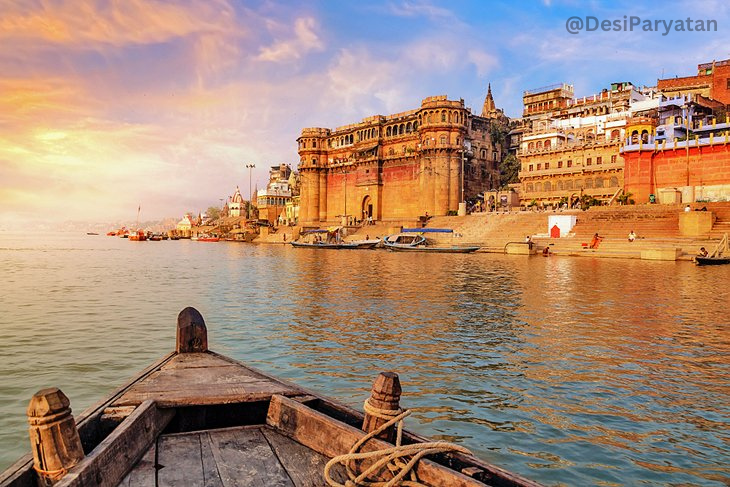14 best famous Places to Visit in Varanasi allow you to feel India’s spirituality at its most vibrant. Each morning, visit the Banaras ghats to see Hindu worshipers wash away their sins in the Ganges River before returning for fire-fueled prayer ceremonies as the sun sets.
At the Manikarnika Ghat, a Hindu holy cremation place, you can view perpetually burning funeral pyres. Are you feeling inspired? You can enhance your relationship with this aspect of Indian culture by releasing your own floating offering, which can be purchased from vendors along the ghats.
Varanasi is more than just a spiritual hub; it also has a strong artistic aspect. See a stunning collection of miniature paintings at Banaras Hindu University’s museum, or try your hand at producing your own masterpiece in a hands-on session at Ruchika Art Gallery. When you’re feeling down, stop by Vishnu Tea Emporium for a cup of the greatest chai in India (and with tea souvenirs to take home).
With our list of the greatest places to see in Varanasi, you may learn more about this historic city.
The Ganges River, named after the Hindu goddess Ganga, is one of India’s most renowned natural wonders. The river flows southeast from the Himalayas in the north to the Bay of Bengal in the south. Between 400 and 600 million people rely on the Ganges River for everyday bathing and drinking water.
Hindus from all over the world travel to Varanasi to purify themselves in the sacred Ganges water and perform ceremonies along the river’s thousands of ghats. For tourists, the river serves as a fixed point of orientation for navigating the city’s convoluted streets, and you’ll undoubtedly spend a lot of time gazing and observing life go on around the Ganges.
Consider getting up early and enjoying a dawn sail down the river with one of the many boatmen that hang out along the ghats.
One of the most popular things to do in Varanasi in the afternoon or early evening is to buy a tiny floating offering packed with fresh flowers and a candle and release it into the Ganges River. The joyful experience will deepen your connection to Hindu culture and stay with you for years to come.
Dasaswamedh Ghat.
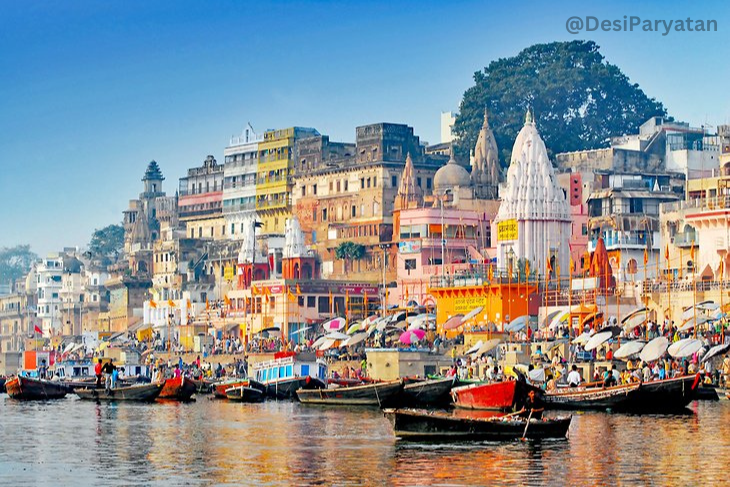
The Dasaswamedh Ghat’s bustling atmosphere makes it one of the top spots to visit in Varanasi. This tourist attraction is a whirlwind of flower vendors selling brilliant blossoms, boat operators selling Ganges River rides, and sadhus (holy men) wearing face paint. During the day, you may spend hours people-watching in this location.
Every night at around 7 p.m., Hindu priests perform the Ganga Aarti at the Dasaswamedh Ghat. The priests, dressed in saffron robes, put out platters of flower petals and other offerings and blow a conch shell to herald the beginning of the spiritual rite.
For around 45 minutes, thousands of tourists assemble to see monks chant and waft tiered platters of sandalwood-scented incense in elaborate patterns. It’s a spectacular sight and one of the best things to do in town.
Useful Tip: If you want to beat the crowds and get a good place for the event, get to the ghat at least a couple of hours early. Views from boats on the river or shop balconies over the ghat are also spectacular.
Assi Ghat.
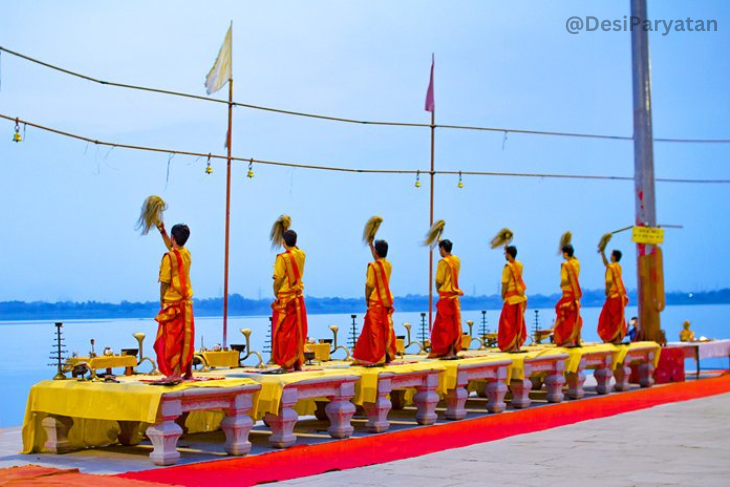
When it comes to popular sites to visit in Varanasi, the city’s southernmost main ghat is consistently at the top of the list. The main feature in Assi Ghat is a Shiva lingam (phallic symbol of the Hindu deity) beneath a sacred fig tree. Every day, hundreds of pilgrims come to worship Lord Shiva after rinsing in the Ganges River.
Feeling a little stiff from your trip? Swing by Assi Ghat around sunrise, when you may join dozens of people for free morning yoga courses accompanied by live music every day. In the evening, tourists can enjoy another Ganga Aarti performance here, which is slightly smaller and more intimate than the one at Dasaswamedh Ghat. It usually begins about 6:30 p.m.
Manikarnika Ghat.
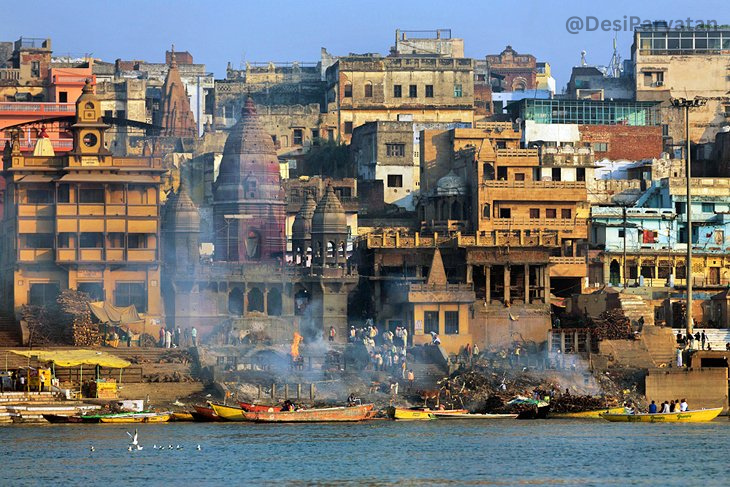
At Manikarnika Ghat, plumes of smoke swirl toward the sky. It’s not from a factory; it’s from the constant cremations that take place on this ghat. Hindus consider Manikarnika Ghat to be one of the most favorable locations for the departed to attain moksha (emancipation from the cycle of spiritual rebirth). The burial pyre at this ghat is constantly burning, and the flame that feeds it is thought to have been lit for generations. Every day, approximately 100 cremations take place at this location.
Tourists are frequently offered tours of the intriguing ghat by priests or guides; however, some might be aggressive in their demands for money. You might observe doms (untouchable caste members) dragging cloth-wrapped bodies on homemade stretchers, as well as stacks of fuel lined up, ready to feed the bonfire.
You may also be given the opportunity to view a cremation up close – for a charge, of course. While profound, the experience is not for the faint of heart, nor is it a standard tourist attraction. Know your boundaries, be respectful, and avoid photographing funerals, mourners, or the deceased.
Usefull Tip: If you’re interested in the traditional cremations but can’t bear the thought of seeing them up close, take a boat excursion along the Ganges River and stop by Manikarnika Ghat. The distance dampens the effect while yet providing travelers with a sense of what’s going on in this historic location.
Dhamek Stupa.
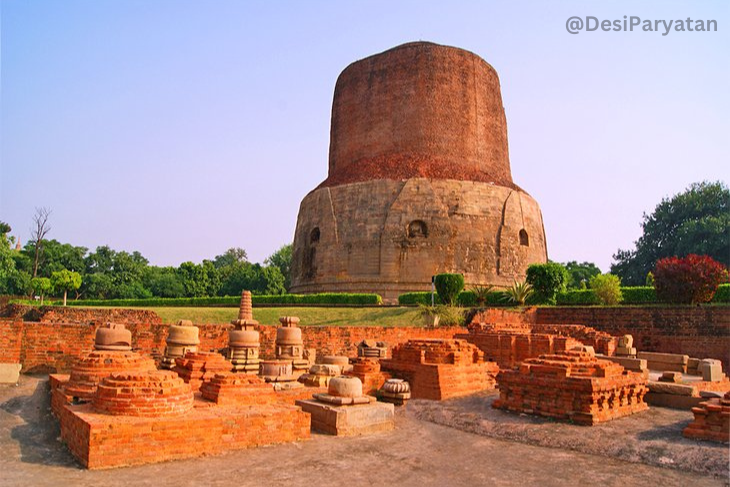
While Hinduism has a stronghold in Varanasi, Buddhism has a significant presence less than 12 kilometers away in the village of Sarnath. The Dhamek Stupa, a large stone and brick building 43.6 meters tall and 28 meters in diameter, can be found here. The stupa was built more than 1,500 years ago to replace a building that was established in 249 BCE.
The faithful believe that after attaining enlightenment, the Buddha came to Dhamek Stupa to deliver his first speech, which revealed the Eightfold Path. As you walk around the site, gaze at the elegant carvings of birds, people, and flowers that decorate the stupa’s walls.
Sarnath also boasts a number of additional tourist attractions that make it an excellent day excursion from Varanasi. Visit the Chaukhandi Stupa (a Buddhist temple that dates back to at least the 6th century), then head to the Sarnath Museum to see the Lion Capital of Ashoka, a sculpture that used to sit atop the Ashoka Pillar in 250 BCE and was designated as India’s National Emblem in 1950.
Before returning to Varanasi, finish the day with a visit to the serene Tibetan Temple near the main market.
Shri Kashi Vishwanath Temple.
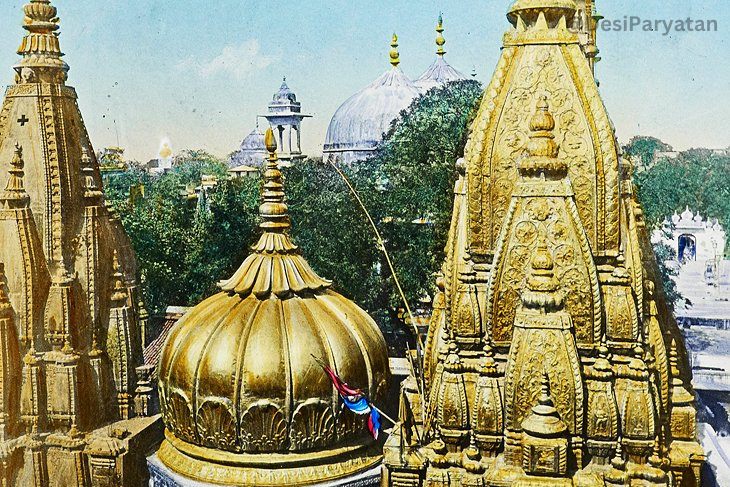
Hindu pilgrims and visitors alike travel hundreds of miles to reach the Shri Kashi Vishwanath Temple, a spiritual destination located approximately four kilometers from the Varanasi Junction railway station near the Manikarnika Ghat.
The magnificent monument, devoted to the Hindu deity Shiva, has gained the moniker “The Golden Temple” because to its spectacular spire, which is coated with 800 kg of pure gold. This temple’s distinct design has influenced the architecture of hundreds of other temples throughout India.
Tourists must store their cameras, phones, bags, and other items in a nearby rentable locker due to strict security procedures. Foreign visitors must also have their passports and visas confirmed at the Darshan Booking Desk. Expect to remove your shoes and join hundreds of other people in line to touch the 60-centimeter-tall, sin-absolving Shiva lingam in a silver altar. It’s a challenging yet rewarding experience.
Usefull Tip: Avoid visiting this sight during Hindu holidays, when devotees can wait in line for up to two days.
Banaras Hindu University.
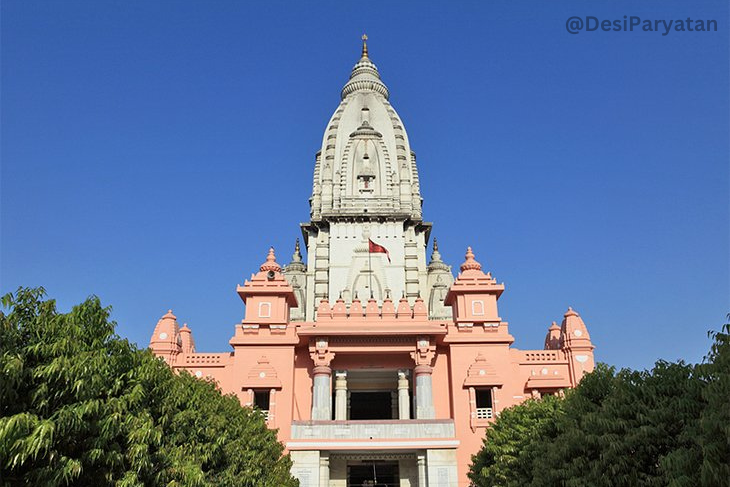
Since its foundation in 1916, Banaras Hindu University has been an integral component of Varanasi’s identity. The prestigious public institution has about 25,000 students, making it one of Asia’s largest residential universities.
There are no hill stations near Varanasi, so come to this lovely 1,300-acre campus to get away from the congestion and bustle of the city. The tranquil location is surrounded by hundreds of towering trees and provides a welcome respite from the busy atmosphere of the Banaras Ghats.
While on campus, stop by the New Vishwanath Temple, a well-known temple that completed its decades-long construction in 1966. The temple is one of the highest in India, standing 77 meters tall, and draws architectural inspiration from the nearby Shri Kashi Vishwanath Temple.
Visitors to the institution should also visit the on-campus museum, Bharat Kala Bhavan. The cultural institution houses a stunning collection of miniature paintings, as well as over 100,000 other archeological and artistic objects.
Ruchika Art Gallery.
Do you want to bring a bit of Varanasi with you? Take a look at the Ruchika Art Gallery, which is located just off Ravindrapuri Road. Ruchika Mehrotra, the gallery’s namesake, has built a warm, lovely shop in which to display a bright array of paintings that reflect the vitality of Varanasi and the ghats in a rainbow of hues.
While some of the larger pieces would necessitate shipment, many of the paintings are tiny enough to fit in a suitcase as keepsakes. There are also nice postcards to purchase.
Ruchika Art Gallery, in addition to displaying locally manufactured creative works, welcomes tourists to pick up a paintbrush during artistic workshops. Contact Ruchika to learn what events are scheduled during your visit to Varanasi.
Shri Durga Temple.
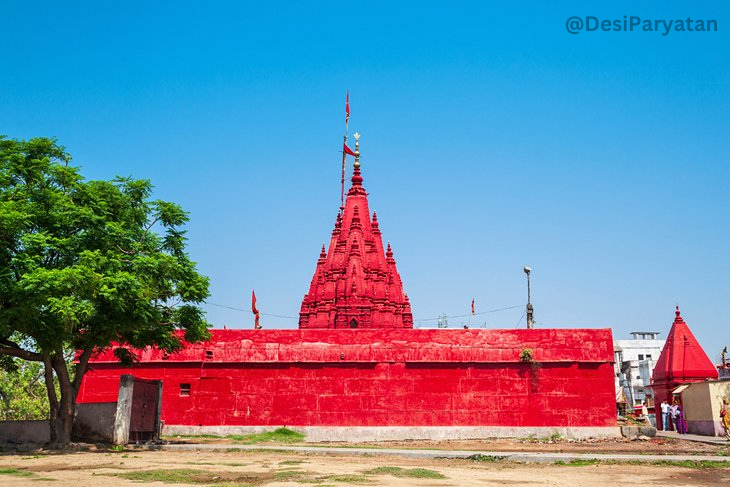
Spiritual activities in and around Varanasi are not limited to the ghats. The Shri Durga Temple is a famous site for Hindus who want to pay homage to the goddess Durga and is only a five-minute walk west of Assi Ghat. The 300-year-old temple is painted bright red from top to bottom, making it impossible to overlook.
The temple’s nickname, “Monkey Temple,” provides you with an idea of what kind of monsters you might encounter in this area. A couple of elegant swans may also be seen floating in the pool of water outside the temple.
Ramnagar Fort.
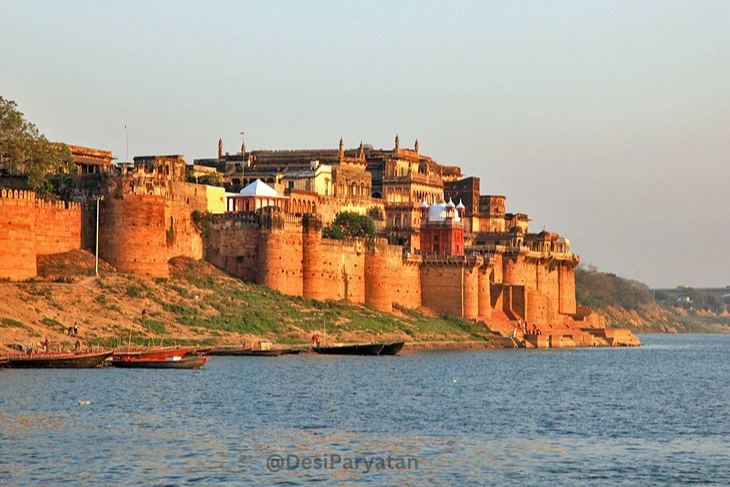
Varanasi is one of the few places in India that does not have a fort. Ramnagar Fort is located about 14 kilometers from the city center.
The 18th-century sandstone fort and castle is no longer utilized as a military fortification, but now contains a strange museum filled with vintage autos, intricate hookahs, antique weapons, jewel-encrusted sedan chairs, and a more than 150-year-old astronomical clock.
After exploring the museum’s archeological treasures, visit the fort’s temples, one of which honors Veda Vyasa, author of the Mahabharata and other key Hindu epics.
Darbhanga Ghat.
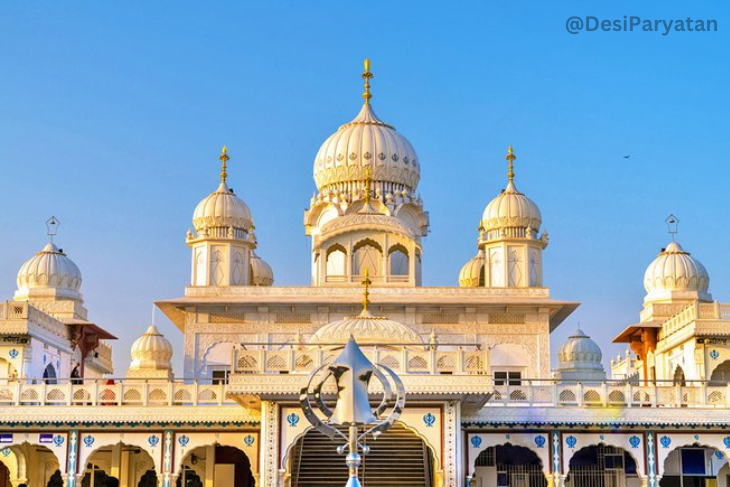
Photographers, take note: Darbhanga Ghat is the greatest place to get stunning images of Varanasi. The ultra-luxurious BrijRama Palace, a historic fort that has subsequently been turned into a heritage hotel, crowns the stairs leading down to the riverfront. The Greek pillars and curving balconies of the home provide a regal backdrop for the region (and your photographs).
Arrive early in the morning to catch unhindered views of the spectacular sunrise over the Ganges River.
Shivala Ghat.
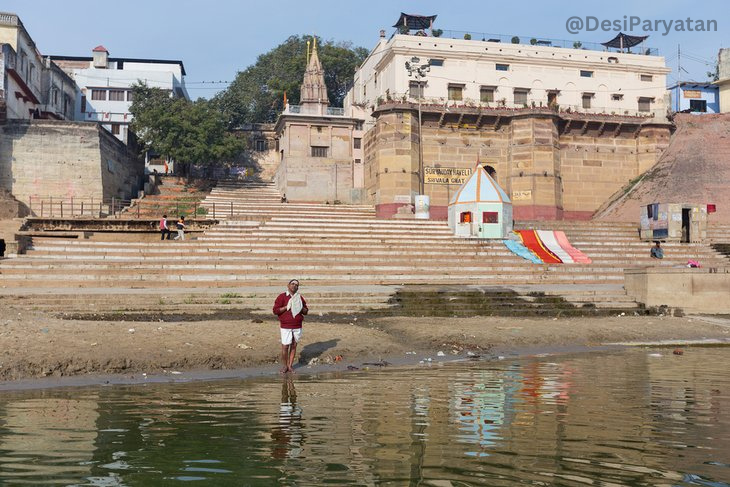
While not as lively as other riverfront places in Varanasi, Shivala Ghat is a nice place to visit if you want some peace & quiet along the Ganges.
Because there are less people at the ghat, it is easier to witness the devout taking their traditional dips in the holy river and families meeting for prayers and tea in the morning. Be prepared to share your space with water buffalo, which are known to congregate in the area. There is also a palace erected in the 19th century by Nepalese King Sanjay Vikram Shah.
It’s also worth spending some time exploring the maze-like streets that lead to Shivala Ghat. The closely crowded area provides an insight into Varanasi residents’ daily lives.
Sankat Mochan Hanuman Temple.
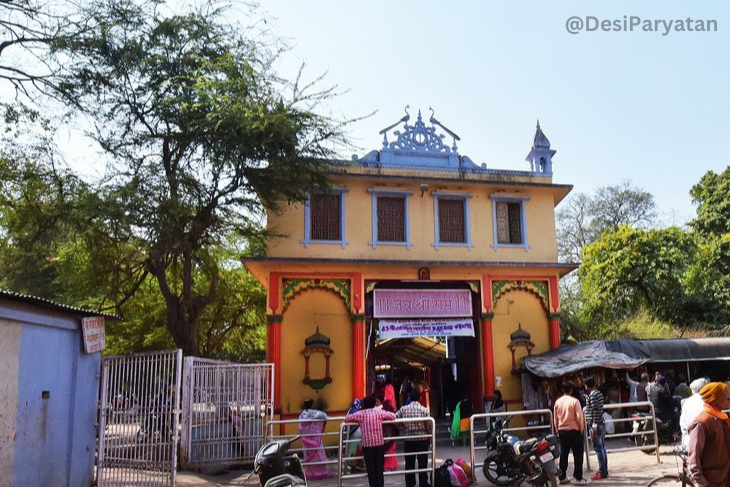
The Sankat Mochan Hanuman Temple, located on the banks of the Assi River, attracts thousands of tourists each day, all anxious to make an offering of sweets and flowers to the Hindu god Hanuman.
According to legend, this temple was built exactly where Hindu saint and poet Goswami Tulsidas had a vision of the monkey god. Keep a watch out for the mischievous critters who are frequently sighted bouncing around the temple.
Useful Tip: April and May are ideal months to see this Varanasi attraction. That’s when the temple conducts its annual “Sankat Mochan Sangeet Samaroh,” a five- to six-day festival of classical music and dance recitals. Performers from all over the world travel to participate in the nearly 100-year-old event.
Vishnu Tea Emporium.

In India, tea is literally a way of life; you’re never more than a few feet away from a chaiwala (tea vendor) brewing up spicy, creamy masala chai from roadside stalls.
Visit the Vishnu Tea Emporium to immerse yourself in this delicious ritual. This casual shop, just a four-minute walk from Dasaswamedh Ghat, offers up-close demonstrations of how to brew masala chai from spices and fresh ingredients.
It also provides a curated assortment of delectable tea and spice mixes for tourists to recreate the traditional Indian drink at home. There’s no pressure to buy, but this is one souvenir you won’t regret purchasing.
Conclusion.
We hope that our investigation of the “14 Best Famous Places to Visit in Varanasi” has shed light on the historical, cultural, and spiritual treasures that characterize this holy city. Varanasi’s ageless charm is embodied in every location, from the ghats along the Ganges to the lively markets and revered temples. Varanasi invites visitors to experience the fusion of tradition and modernity with its magical atmosphere and spiritual aura. May the spiritual energies and cultural diversity you experience while visiting these well-known sites create a lasting impression on your spirit. Beyond the mundane, Varanasi delivers a spiritual experience, as every stone in the city tells a tale.
FAQs 14 best famous Places to Visit in Varanasi.
1. Is Varanasi safe for tourists, especially around the famous places to visit?
– A: Yes, Varanasi is generally safe, and the famous places attract a significant number of tourists. However, it’s advisable to remain cautious and follow local guidelines.
2. Are there specific dress codes to adhere to when visiting temples in Varanasi?
– A: While there may not be strict dress codes, it’s respectful to wear modest attire when visiting religious places in Varanasi.
3. Can I participate in religious rituals or ceremonies at these famous places in Varanasi?
– A: Yes, many places in Varanasi allow visitors to participate in rituals. However, it’s essential to be respectful and follow local customs.
4. What is the best time to visit the famous places in Varanasi to avoid crowds?
– A: Early mornings are generally quieter, providing a serene atmosphere in many places. However, some attractions may be busy during specific festivals or events.
5. Are there guided tours available for exploring the famous places in Varanasi?
– A: Yes, guided tours are available for many famous places, offering insights into the history, significance, and cultural aspects of each location.



